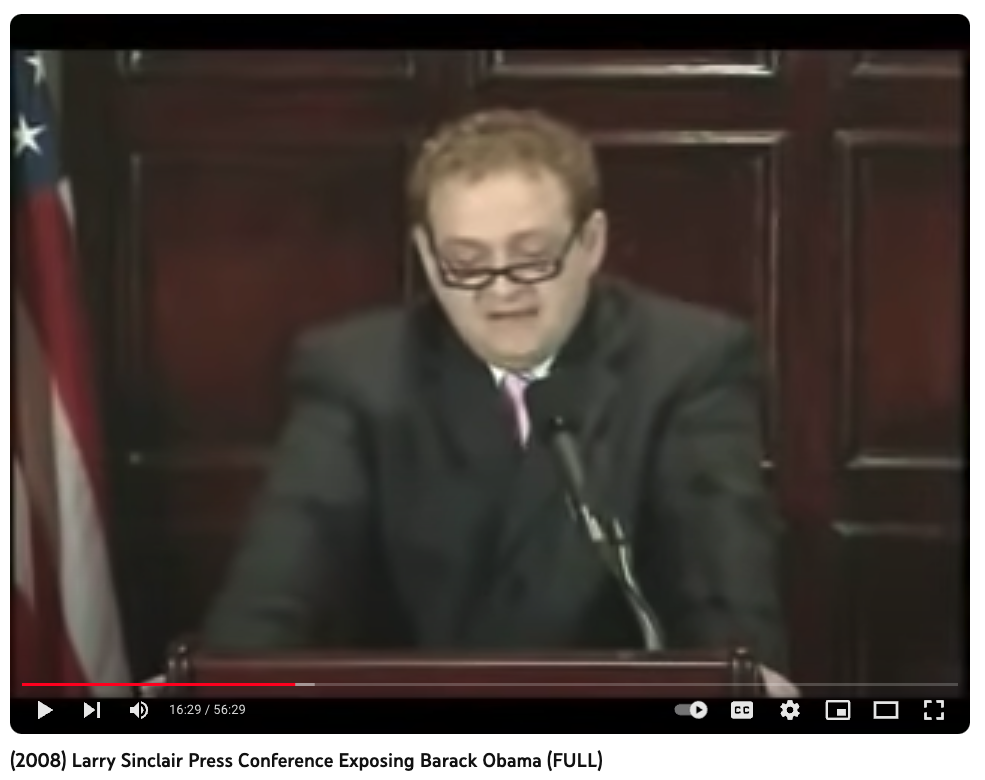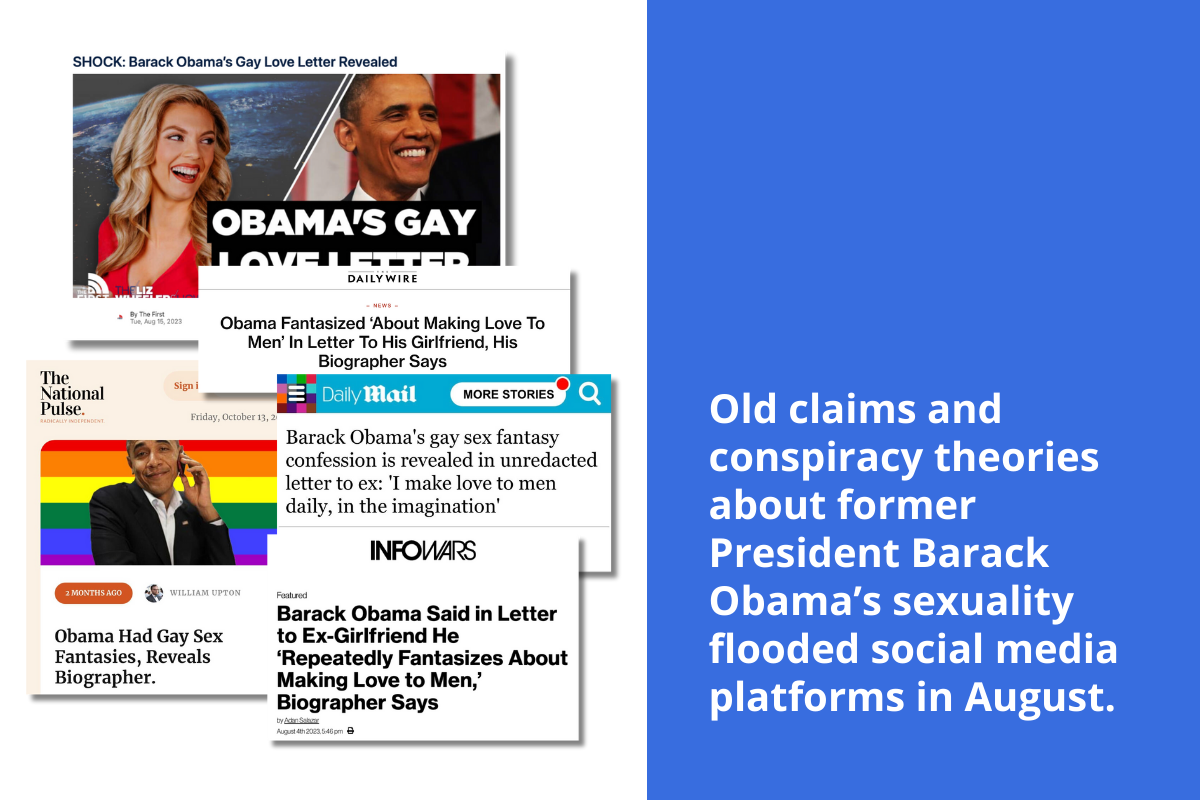He spent eight years in the White House, nearly every move recorded by press and watched by staff. But six years after former President Barack Obama left office, some conservative media figures aggressively circulated a salacious rumor: that Obama is secretly gay.
The claim percolated across social media and conservative news sites for weeks throughout August and reverberated throughout September.
An Aug. 3 headline in the Tucker Carlson-founded Daily Caller said “Obama once wrote to ex-girlfriend that he ‘repeatedly fantasizes about making love to men,’ biographer says.” A day later, Infowars, the website founded by conspiracy theorist Alex Jones, published a similar story.
By Aug. 15, conservative news sites had published over 20 stories with headlines about the former president’s “gay sex fantasies” or his “gay sex fantasy confession.” Carlson, the former Fox News host, on Aug. 30 told podcaster Adam Carolla that, “In 2008, it became really clear that Barack Obama had been having sex with men.”
Really clear? As part of PolitiFact’s work reporting on misinformation online, we found this claim to be anything but.
By the time Carlson made this statement, speculation about Obama’s sexuality had fused into even broader online conspiracy theories, including that Obama had murdered both his chef Tafari Campbell and comedian Joan Rivers to keep his secret.
Videos on Facebook revived the 15-year-old unsubstantiated allegations of Larry Sinclair, a man with a criminal history of fraud and forgery who in 2008 claimed to have had drug-fueled sex with Obama in 1999.
On Sept. 6, Carlson fanned interest in Obama’s sexuality, releasing on X a new interview with Sinclair in which Sinclair repeated his allegations.

(Screenshot of X post)
This narrative’s dominance online prompted us to explore this renewed speculation’s source and spread. We learned that the two pieces of “evidence” fueling this claim — a letter and Sinclair’s statements — need more context than the headlines supply.
Experts told us that although social media helped accelerate these claims, the political debate about sexuality and gender helped them thrive.
“This is really neatly entangled with the upcoming electoral cycles, the ongoing political assaults on LGBTQ+ and in particular trans people,” said TJ Billard, assistant professor of communication at Northwestern University. Anxiety that people in power are pushing a secret “gay agenda,” helps fuel theories that those powerful people are themselves secretly gay, Syracuse University associate professor Joshua P. Darr said.
It also weaves into existing conspiracies. Allegations by Sinclair include drug use, secret limo rendezvous and murder, drawing on broader, QAnon-like fears of hidden and violent sexual behavior by powerful people. That conspiracy theory holds that powerful, left-leaning figures from politics, business and entertainment are part of a cabal that engages in pedophilia and cannibalism.
These claims about Obama’s sexuality are rooted in two sources, both which need more explanation and neither of which serve as proof.
The love letter
On Nov. 20, 1982 — seven years before he met Michelle Robinson, his future wife of 31 years — Obama wrote a four-and-a-half-page letter to then-girlfriend, Alex McNear.
The letter, now stored at Emory University’s Stuart A. Rose Manuscript, Archives, and Rare Book Library in Atlanta, shows Obama, then 21, exploring where cruelty comes from, whether cruelty is intrinsic to being a man in Western society and how people cope with the pain of existence and eventual death. He also expresses romantic affection for McNear and satisfaction at meeting an intellectual match.
Much of the letter seems to be a continuation of a conversation with McNear. Neither McNear nor Obama responded to PolitiFact’s requests for comment.
The paragraph that Obama’s detractors focused on is on the fourth page: “In regards to homosexuality, I must say that I believe this is an attempt to remove oneself from the present, a refusal, perhaps, to perpetuate the farce of earthly life. You see, I make love to men daily, but in the imagination. My mind is androgynous to a great extent, and I hope to make it more so, until I can think of people, not women as opposed to men. But returning to the body, I see that I have been made a man, and physically, in life, I choose to accept that contingency.”
Fast-forward 28 years to 2010, when McNear shared the letter (and several others) with Pulitzer Prize-winning author David Garrow, who was working on a 1,472-page Obama biography.
McNear had redacted the paragraph in question, Garrow told PolitiFact, but later paraphrased its contents in time for Garrow to publish his 2017 book, “Rising Star: The Making of Barack Obama.” In the book, Garrow included a sentence about the letter that said Obama had “considered gayness.” The comment generated minor news coverage at the time.
Once the letters became public at Emory in fall 2017, Garrow sent a longtime friend and Emory professor Harvey Klehr to transcribe the redacted portion. The June 2018 paperback edition of Garrow’s book newly contained several lines from the letter, including parts of this paragraph.
Garrow told PolitiFact he included the passage in the paperback because, “My whole attitude is you just put things on the record.” But the paragraph did not change the biographer’s view of Obama or his sexuality.
“My substantive view is that this is not in any way remarkable,” Garrow said.
In the five years since they were published, the letter’s partial contents garnered almost no media attention.
Larry Sinclair’s statements
Sinclair’s involvement goes back to Obama’s first campaign for president.
On June 18, 2008, Sinclair, then 46 and living in Duluth, Minnesota, held a press conference at the National Press Club in Washington, D.C. He opened it by describing himself as “a former recreational drug user, drug trafficker and I’m a convicted felon for crimes of forgery, bad checks and theft by check.” He also said he’d had three legal name changes.
Sinclair reiterated claims he had initially made in a since-deleted YouTube video — that during a 1999 trip to Chicago, a limo driver introduced him to Obama, then a state senator. Sinclair said he and Obama did drugs and had a sexual encounter in the limo and again the next day.
Sinclair’s story further alleged that a former choir director at Obama’s Chicago church had an intimate relationship with Obama — one that Sinclair suggested ended in the director’s murder.
Taking reporters’ questions, Sinclair said he planned to provide phone records, financial records, and a list of his doctors on his website larrysinclair.org, some as soon as that afternoon. An archived version of the site from August 2009 shows no such information posted. The website links to a PDF showing a receipt from a Comfort Inn in Gurnee, Illinois, in 1999, and a PDF showing a limousine company business registration. It also includes an unsigned affidavit by Sinclair that is addressed to the Chicago police.
“The burden is now off of me,” Sinclair said at the press event. “I am now done. It is for others to find the corroborating evidence of my story.” He gave a name for the limo driver and provided several phone numbers he said he was using during the fall of 2007, saying he hoped that someone could “connect the dots.”

(Screenshot of YouTube video)
PolitiFact’s attempts to contact Sinclair were unsuccessful. We found no additional evidence to substantiate his claims, and we couldn’t locate a person by the limo driver’s name.
In 2008, the media largely dismissed Sinclair’s allegations as lacking credibility. His lack of corroborating evidence and past criminal history made him hard to trust, judging by the news coverage and the comments from people who remember the event: In a 2008 story, Politico reported that Sinclair’s criminal record spanned close to three decades and revealed what it described as “a specialty in crimes involving deceit.”
Public records show arrests for Sinclair in Colorado, Florida and South Carolina on charges that include grand larceny, forgery, fraud and disorderly conduct, many from the mid-’80s. He says he was sentenced to 16 years in Colorado, but only served only some of that sentence; Colorado records show he was held on forgery and fraud charges at the time. In 2014, Florida Department of Law Enforcement records show, he was arrested on a charge of larceny as an out-of-state fugitive.
Sinclair’s allegations have kept circulating. In 2009, he wrote and self-published a now hard-to-find book titled “Barack Obama & Larry Sinclair: Cocaine, Sex, Lies & Murder?” In 2018, he ran unsuccessfully for mayor in Cocoa, Florida. Sinclair has since maintained a presence on X, formerly Twitter, describing himself as an investigative journalist.
Sinclair’s claims have popped up on Facebook videos online over several years. They gained steam as the 1982 letter gained attention.
When the Carlson interview resurfaced Sinclair’s claims, more than 36 million people viewed it on X, exposing his allegations to a new generation of social media users who offered their commentary, speculations on Sinclair’s credibility, and reactions.
Why now?
Online claims about Obama’s sexuality resurfaced after Aug. 2, when the Jewish magazine Tablet posted a wide-ranging interview with Garrow. In it, the biographer mentioned the redacted letter and its reference to homosexuality.
As news about the story spread across the conservative media ecosystem, Garrow said he received 20-plus media requests including from Sean Hannity, Glenn Beck, and Lou Dobbs.
Online media networks are built to amplify stories like these, said Joel Penney, associate professor of communication at Montclair State University. So, when they get picked up, they get “very big very fast.”

(Screenshots of news headlines)
Soon, the claims devolved into conspiratorial Facebook videos with false captions such as “Obama chef ELIMINATED for knowing Obama’s gay secret!” and “Joan Rivers was sacrificed after she exposed Barack Obama being gay!!!”
There is no evidence supporting either claim.
Jenny Rice, associate professor of writing, rhetoric, and digital media at the University of Kentucky, said conspiracy theorists may have also found intrigue in the way the paragraph from Obama’s 1982 letter came to light.
In the world of conspiracy theories, Rice said, “things that are secret and hidden, become almost de facto proof that something very nefarious or evil is happening.”
Penney said, “In general, the pleasure of conspiracy theory is the sense of satisfaction or pleasure of knowing the real story is not the one that they’re telling you.”
Obama, the first and only Black president in U.S. history, has long been a magnet for conspiracy theories with racist roots, most notably regarding claims that his birth certificate is fake. (It’s real.)
Penney said Obama also challenges traditional stereotypes of masculinity, making him an easier target for this claim: “He’s an intellectual. He’s a college professor. He’s kind of skinny. He’s not like a big muscle guy.”
Obama remains popular in recent polls. In 2018, a Pew survey asked people to say which president they believed had done “the best job during your lifetime.” Obama took first place, trailed by Bill Clinton and Ronald Reagan. In 2022, people polled by NBC News said they had more positive feelings toward Obama than they did toward at least six other public figures, including Donald Trump and President Joe Biden.
Because Biden was Obama’s vice president, Obama also serves as a proxy for attacks against Biden. Former Fox News commentator Megyn Kelly, for example, said that some believe Biden is a “shadow puppet” for Obama. Podcaster and Trump ally Dan Bongino argued Obama is “the real president” now.
“He’s out of power,” Penney said of Obama, “but I still think that in the national imagination, he still has this very strong image.”
Georgia-based reporter Jeff Amy and PolitiFact Researcher Caryn Baird contributed to this report.












